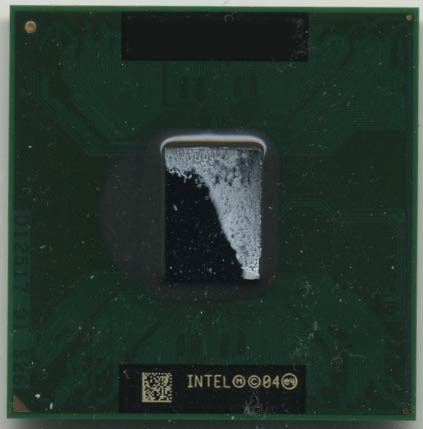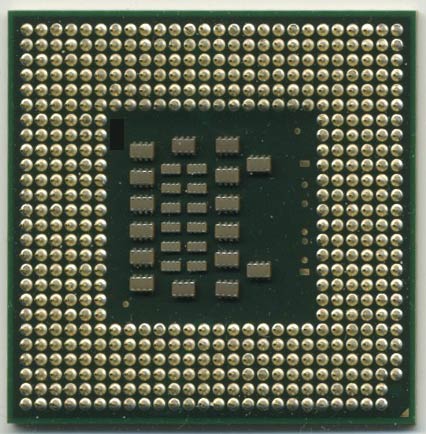Intel Yonah Performance Preview - Part I: The Exclusive First Look at Yonah
by Anand Lal Shimpi on November 30, 2005 2:50 AM EST- Posted in
- CPUs
Intel, oh Intel, how uninteresting your processors have been to us for so long now. Where have the days of the Northwood gone? Prescott brought us a minor bump in clock speed, minor increases in performance, and more importantly - major increases in power bills. But if any company can go down the wrong path for five years and still come out on top, it’s Intel. So starting next year, we’ll start seeing a new Intel. A more power conscious Intel and to kick it all off will be Intel’s first Earth-friendly dual core processor: Yonah.
As the successor to the current Pentium M (Dothan) and the predecessor to next year’s Conroe, Merom and Woodcrest cores, Yonah is a very important chip. As a mobile processor Yonah will bring dual core to thin and light notebooks, basically anywhere you’d find a Pentium M, you’ll now be able to find two Pentium Ms. The implications for mobile performance are huge, as multitasking on notebooks has rarely been all that great of an experience. At the same time, Yonah is so much more than just a dual core mobile processor - it’s a predictor of the performance of Intel’s next-generation desktop micro-architecture. Sure, it won’t have all of the architectural bells and whistles that we’ll see when Conroe debuts at the end of next year, but it’ll have many and that makes it a reference point.
The problem with the Pentium M architecture has been that although it’s traditionally done well at office tasks and obviously in the power consumption department, it has lagged behind the Pentium 4 and Athlon 64 when it comes to FP intensive applications such as video encoding, and to a lesser degree, 3D gaming. With Yonah, Intel has promised to address those performance issues, and even more so with their next-generation micro-architecture later next year. But we tend to want to see things for ourselves, and Yonah will at least give us an indication of how things have improved since Dothan, and whether or not Intel is on the right track to replacing the Pentium 4.
By now we’ve hopefully stressed the importance of Yonah, and there’s just one more detail to mention - we have one.
The Platform - Yet Another Socket
While the launch of Yonah still won’t be until January of next year, we’ve had a chip for the past month, unfortunately, we haven’t had a motherboard to stick it in. We finally got one two days ago, which is why you’re seeing this article now, instead of more pictures of our Yonah posing alongside the Xbox 360. The problem is that Intel seems to have changed sockets once more, meaning that Yonah is not backwards compatible with the original Pentium M socket.

If you’ll remember back to the introduction of the Pentium M, Intel introduced a brand new socket for the processor: Socket-479. Back then, the desktop Pentium 4 still used the pin-based Socket-478, so the different pin-out was a bit of a pain to deal with as we all wanted to be able to stick Pentium Ms in our Pentium 4 motherboards.

The Yonah socket is still a 479-pin interface, however the pin-out has been changed once more, and of course Yonah won’t even physically fit into any current Pentium M motherboards. Instead, you’ll need a brand new motherboard with a brand new chipset. So if you invested in any of the handful of desktop Pentium M motherboards that were released over the past year, you’re unfortunately out of luck.

Yonah (left) vs. Dothan (right) - Note the different pin-out
What’s this about a new chipset? Well, it’s not exactly a new chipset, rather it’s Intel’s mobile 945 chipset - the mobile version of the desktop chipset we’ve had for quite some time now. The platform we’re testing on in particular uses Intel’s 945G chipset, with integrated graphics, but of course we aren’t too interested in integrated graphics performance so we’ll be using the PCIe x16 slot on the board.
While we can’t tell you who makes the motherboard we’re testing with, the important thing to note is that it is a desktop motherboard made specifically for Yonah. It’s got a single PCIe x16 slot, meaning you don’t have to rely on integrated graphics, and all of the bells and whistles you’d expect from a desktop motherboard; this could very well be the heart of your next system.
We’ve been hearing that Pentium M based desktops will become a lot more common next year, and this motherboard is definitely an indication of that.










135 Comments
View All Comments
edwardhchan - Wednesday, November 30, 2005 - link
For those who care, this is probably the chip that will make it into the Macs next year. Drooling over a new powerbook that dualboots....bldckstark - Wednesday, November 30, 2005 - link
I suppose you will be drowning yourself when you start dreaming of a triple boot with the GoogleOS? On Cell processors? With SkyFi wireless bouncing signals off of the moon (system outage during new moon transition)?Dreams of vaporware let you down more often than a topless dancer when you run out of ones.
I do however often dream about my robotically driven car so that I may play PC games from the back seat on my 60" OLED TV during the drive to work. Imagine internet access on the road then. All the mobile PRON. Gives a new meaning to the word carjack doesn't it?
dougSF30 - Wednesday, November 30, 2005 - link
and on the next generation process.So really, one could say it this way:
AMD's IMC allows their 90nm DC part with 1/2 to 1/4 the L2 cache to perform better than Intel's new 65nm part running at the same clock speed.
fitten - Thursday, December 1, 2005 - link
Only fanbois would say that (or folks who just don't know about computer architectures).a) The AMD Athlon64 has a faster FPU than the Yonah. Benchmarks doing heavy FPU will do better aon the Athlon64.
2) The Athlon64 has more memory bandwidth available to it than the Yonah. While chipsets for Yonah are dual channel, the chip itself still seems to be single channel (like it's predecessors - for power reasons). This configuration does give better performance than all single channel but it isn't as good as all dual channel.
D) Despite these two disadvantages (there are a few others), Yonah still manages to stay close to the Athlon64 parts on average. Some benchmarks it's actually a little faster and some it's a fair bit slower.
One of the best unsung things about the Athlon64 X2s is that a single core Athlon64 only benefits marginally in real benchmarks with dual channel memory compared to single channel memory (ignore synthetic benchmarks). The best I've seen is 20% faster but it is typically on the order of 7% faster. This means that adding a second core, which can double the bandwidth requirements to main memory in really bad situations, can be almost completely satisfied by dual channel. Using the best cases above, the benchmark would need 1.20x the bandwidth of single channel, so this same with a dual core would need 2.4x single channel bandwidth. That's only lacking by 20%.
Compare this to the Pentium4 which gets very large speedups (60% or more sometimes) from dual channel over single channel. Two of those cores doing that would need 3.2x single channel, but dual channel only gives 2.0x meaning that the Pentium4 dual core may have a deficit of 60% of the bandwidth needed to run both cores full-tilt.
Leper Messiah - Thursday, December 1, 2005 - link
But what does the above have to do with Yonah's performance. Architecturally, Yonah is far closer to K8 than to netburst. It should have more than enough bandwidth provided with the "667" FSB, esp. if its dual channel.Anemone - Wednesday, November 30, 2005 - link
I'd agree, the basic core of the A64 chip is quite superior to the P-M, meaning when you take out the cache factor (remember that also applies to programs whose requirements exceed the 2M cache as well so think ahead on that).And yes someone mentioned power requirements going up for Merom - which might require a moderating of clockspeeds to keep it in check in the mobile arena.
Basically for AMD and Nvidia a big opportunity exists here to deliver (and deliver soon) the M2 and take advantage of a very good, but not superb chip from Intel. It remains to be seen if that can be done.
Yonah is good, and would have been great if it had delivered when originally promised (Aug 05, from very early roadmaps), however it is not stellar. But as an overall mobile platform is is the current best. Kudos Intel.
dougSF30 - Wednesday, November 30, 2005 - link
And as far as power goes, Intel admitted that 64-bit would've pushed the power way up on Yonah, so you need to consider that when looking at Yonah TDP vs. X2 TDP.Amagus - Wednesday, November 30, 2005 - link
I'm assuming the load tests were for both cores being fully stressed. What I would have like to have seen were power numbers on a similarly configured Dothan desktop. That would give us a better idea of how expensive that 2nd core is and how good Intel's 65nm process is.
-Amagus
phaxmohdem - Wednesday, November 30, 2005 - link
Well, I'm fairly impressed with this chip personally. It's definately not the "spooge your pants" object of Techno-Lust many of us were hoping for, but as a man truely impressed with the performance of his Banias Pentium M 1.6GHZ CPU, I can only imagine how awesome that 2.0 Dually would be in a laptop.If Conroe can pull off slightly better performance per clock + higher clock speeds + add an integrated Mem/PCIe controller.... We might see some good shiznat in the year to come.
NullSubroutine - Wednesday, November 30, 2005 - link
Intel at least has something to offer if you want a decent notebook. I think it all comes down to cost. It probably wont be as equally fast as an AMD dual core Turion, but if it costs alot more, the whole "less power" really doesnt sell me on the extra money I would have to spend for the entire Intel setup.The product is a decent product, it doesnt blow you away, but it is something that you can get in a new system and not be disappointed (unless you encode/decode). I personally plan to buy a dual core laptop sometime at the end of spring, if the price is right, then it might be what I am getting (unless they produce that Monroe by then).